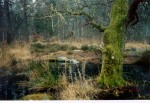The ILTER workshop at Snowbird in August 2000 resulted in a meeting between US LTER and French Zones Ateliers (ZA) participants mid January 2001 in Versailles, near Paris. ZAs are part of the French Centre National dela Recherche Scientifique (CNRS, http://www.cnrs.org). These meetings explored the existing and potential developments for ecological networks and collaborations. An afternoon trip to Forest Fontainebleau and Station Biologique de Foljuif provided an opportunity for participants to explore the research sites.
Forest Fontainebleau, a Man and the Biosphere (MAB) reserve since December 1998, is one of the few very old lowland forests in Europe. It is located south of Paris, west of the Seine. The forest was last logged in 1372 and possibly not since. The area has 20 to 30 year storm events with winds up to 140 km/hr. The most recent of these occurred in December 1999. The forest is dominated by beech trees with 5-15% in gap regeneration at any one time. Plantings have included braken fern, oak and scots pine and, gap dynamics have lead to low diversity.
The Station Biologique de Foljuif is associated with Ecole Normale Superiore. It was created decades ago as a field station for forest studies, use now includes experimental ecology, such as biodiversity, population dynamics, landscape fragmentation, and breeding termites. The station includes 50 hectares of land although additional land is being acquired in order to focus more on long-term experiments.
New work includes an interest in mesocosm manipulations and linking experimental ecology and field observations from different landscapes. Since human activities impact carbon storage in forests and in rural environments, the Forest Fontainblau and the Station Biologique de Foljuif are sites from which community structure and ecosystem function can be considered.

 Enlarge this image
Enlarge this image
